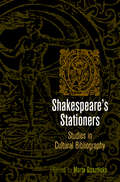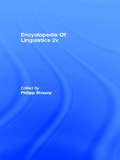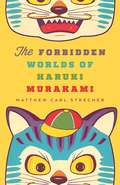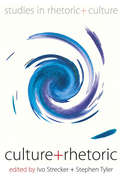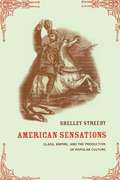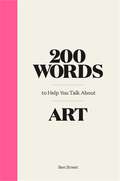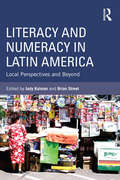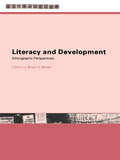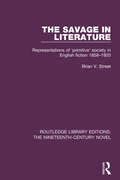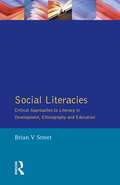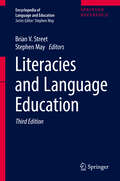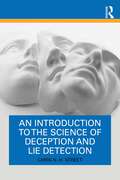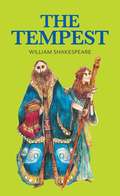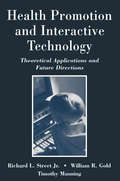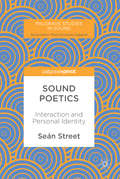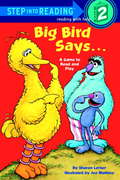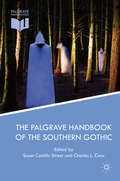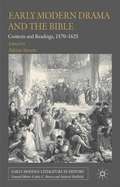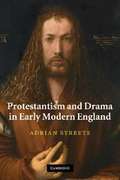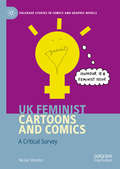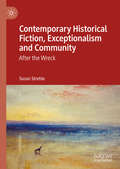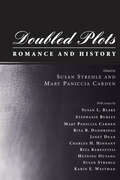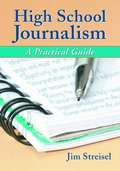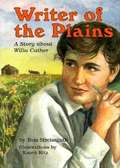- Table View
- List View
Shakespeare's Stationers: Studies in Cultural Bibliography (Material Texts)
by Marta StraznickyRecent studies in early modern cultural bibliography have put forth a radically new Shakespeare—a man of keen literary ambition who wrote for page as well as stage. His work thus comes to be viewed as textual property and a material object not only seen theatrically but also bought, read, collected, annotated, copied, and otherwise passed through human hands. This Shakespeare was invented in large part by the stationers—publishers, printers, and booksellers—who produced and distributed his texts in the form of books. Yet Shakespeare's stationers have not received sustained critical attention.Edited by Marta Straznicky, Shakespeare's Stationers: Studies in Cultural Bibliography shifts Shakespearean textual scholarship toward a new focus on the earliest publishers and booksellers of Shakespeare's texts. This seminal collection is the first to explore the multiple and intersecting forms of agency exercised by Shakespeare's stationers in the design, production, marketing, and dissemination of his printed works. Nine critical studies examine the ways in which commerce intersected with culture and how individual stationers engaged in a range of cultural functions and political movements through their business practices. Two appendices, cataloguing the imprints of Shakespeare's texts to 1640 and providing forty additional stationer profiles, extend the volume's reach well beyond the case studies, offering a foundation for further research.
Encyclopedia of Linguistics
by Philipp StraznyUtilizing a historical and international approach, this valuable two-volume resource makes even the more complex linguistic issues understandable for the non-specialized reader. Containing over 500 alphabetically arranged entries and an expansive glossary by a team of international scholars, the Encyclopedia of Linguistics explores the varied perspectives, figures, and methodologies that make up the field.
The Forbidden Worlds of Haruki Murakami
by Matthew Carl StrecherIn an "other world" composed of language--it could be a fathomless Martian well, a labyrinthine hotel or forest--a narrative unfolds, and with it the experiences, memories, and dreams that constitute reality for Haruki Murakami's characters and readers alike. Memories and dreams in turn conjure their magical counterparts--people without names or pasts, fantastic animals, half-animals, and talking machines that traverse the dark psychic underworld of this writer's extraordinary fiction.Fervently acclaimed worldwide, Murakami's wildly imaginative work in many ways remains a mystery, its worlds within worlds uncharted territory. Finally in this book readers will find a map to the strange realm that grounds virtually every aspect of Murakami's writing. A journey through the enigmatic and baffling innermost mind, a metaphysical dimension where Murakami's most bizarre scenes and characters lurk, The Forbidden Worlds of Haruki Murakami exposes the psychological and mythological underpinnings of this other world. Matthew Carl Strecher shows how these considerations color Murakami's depictions of the individual and collective soul, which constantly shift between the tangible and intangible but in this literary landscape are undeniably real. Through these otherworldly depths The Forbidden Worlds of Haruki Murakami also charts the writer's vivid "inner world," whether unconscious or underworld (what some Japanese critics call achiragawa, or "over there"), and its connectivity to language. Strecher covers all of Murakami's work--including his efforts as a literary journalist--and concludes with the first full-length close reading of the writer's newest novel, Colorless Tsukuru Tazaki and His Years of Pilgrimage.
Culture And Rhetoric
by Ivo Strecker Stephen TylerWhile some scholars have said that there is no such thing as culture and have urged to abandon the concept altogether, the contributors to this volume overcome this impasse by understanding cultures and their representations for what they ultimately are - rhetorical constructs. These senior, international scholars explore the complex relationships between culture and rhetoric arguing that just as rhetoric is founded in culture, culture is founded in rhetoric. This intersection constitutes the central theme of the first part of the book, while the second is dedicated to the study of figuration as a common ground of rhetoric and anthropology. The book offers a compelling range of theoretical reflections, historical vistas, and empirical investigations, which aim to show how people talk themselves and others into particular modalities of thought and action, and how rhetoric and culture, in this way, are co-emergent. It thus turns a new page in the history of academic discourse by bringing two disciplines - anthropology and rhetoric - together in a way that has never been done before.
American Sensations: Class, Empire, and the Production of Popular Culture
by Shelley StreebyBy focusing on sensationalist literature of the period, Streeby explores issues of race, class, popular culture, and notions of empire in America around the U.S.-Mexican war.
200 Words to Help You Talk about Art
by Ben StreetHave you have ever felt at a disadvantage when joining in a conversation on a subject that you aren't confident about? If yes, this new book series is for you. Each book features definitions of two hundred words frequently used to describe and discuss a smart subject.200 Words to Help You Talk About Art is designed to demystify jargon-based art language and make you at ease holding a conversation on the topic. Art can be intimidating to the uninitiated, but with Ben Street's help you'll know your Dada from your diptych in no time. The book is written with digestible text enabling a quick and easy understanding of various topics while broadening your artistic vocabulary.200 Words to Help You Talk About Art is one of two new titles beginning a series of smart subjects, also including philosophy, psychology, and music.
200 Words to Help You Talk about Art
by Ben StreetHave you have ever felt at a disadvantage when joining in a conversation on a subject that you aren't confident about? If yes, this new book series is for you. Each book features definitions of two hundred words frequently used to describe and discuss a smart subject.200 Words to Help You Talk About Art is designed to demystify jargon-based art language and make you at ease holding a conversation on the topic. Art can be intimidating to the uninitiated, but with Ben Street's help you'll know your Dada from your diptych in no time. The book is written with digestible text enabling a quick and easy understanding of various topics while broadening your artistic vocabulary.200 Words to Help You Talk About Art is one of two new titles beginning a series of smart subjects, also including philosophy, psychology, and music.
Literacy and Numeracy in Latin America: Local Perspectives and Beyond
by Brian Street Judy KalmanLatin American Literacy and Numeracy Studies (LALNS) are fairly unknown in other parts of the world. This book charts new directions in LALNS and explores the relationship between these studies and international perspectives. Calling upon social practice approaches, New Literacy Studies, sociolinguistics, discourse analysis and other paradigms, the contributors identify both convergent and divergent literacy and numeracy issues within the region as well as beyond the Latin American context. Literacy and Numeracy in Latin America moves the field forward by bringing LALNS into wider focus and helping readers to understand the synergy with work from other perspectives and from other parts of the world and the implications for theory and practice. A lack of translated work until now between Latin America and, in particular, the UK, US, and Europe, has meant that such important overlaps between areas of study have gone unappreciated. In this way this volume is the first of its kind, a significant and original contribution to the field.
Literacy and Development: Ethnographic Perspectives (Literacies)
by Brian V. StreetLiteracy and Development is a collection of case studies of literacy projects around the world.The contributors present their in-depth studies of everyday uses and meanings of literacy and of the literacy programmes that have been developed to enhance them. Arguing that ethnographic research can and should inform literacy policy in developing countries, the book extends current theory and itself contributes to policy making and programme building.A large cross-section of society is covered, with chapters on Women's literacy in Pakistan, Ghana, and Rural Mali, literacy in village Iran, and an 'Older Peoples' Literacy Project.This international collection includes case studies from: Peru, Pakistan, India, South Africa, Bangladesh, Mali, Nepal, Iran, Eritrea, Ghana.
The Savage in Literature: Representations of 'primitive' society in English fiction 1858-1920 (Routledge Library Editions: The Nineteenth-Century Novel #37)
by Brian V. StreetFirst published in 1975, this study is concerned with the representation of non-European people in English popular fiction in the period from 1858-1920. It examines the developments in thinking about people across the world and shows how they affected writers’ views of evolution, race, heredity and of the life of the so-called ‘primitive’ man. This book will be of interest to those studying 19th century literature.
Social Literacies: Critical Approaches to Literacy in Development, Ethnography and Education (Real Language Series)
by Brian V. StreetSocial Literacies develops new and critical approaches to the understanding of literacy in an international perspective. It represents part of the current trend towards a broader consideration of literacy as social practices, and as its title suggests, it focuses on the social nature of reading and writing and the multiple character of literacy practices.
Literacies and Language Education: Social Literacies: Critical Approaches To Literacy In Development, Ethnography And Education (Encyclopedia of Language and Education)
by Brian V. Street Stephen MayIn this third, fully revised edition, the 10 volume Encyclopedia of Language and Education offers the newest developments, including an entirely new volume of research and scholarly content, essential to the field of language teaching and learning in the age of globalization. In the selection of topics and contributors, the Encyclopedia reflects the depth of disciplinary knowledge, breadth of interdisciplinary perspective, and diversity of socio-geographic experience in the language and education field. Throughout, there is an inclusion of contributions from non-English speaking and non-western parts of the world, providing truly global coverage. Furthermore, the authors have sought to integrate these voices fully into the whole, rather than as special cases or international perspectives in separate sections. The Encyclopedia is a necessary reference set for every university and college library in the world that serves a faculty or school of education, as well as being highly relevant to the fields of applied and socio-linguistics. The publication of this work charts the further deepening and broadening of the field of language and education since the publication of the first edition of the Encyclopedia in 1997 and the second edition in 2008.
An Introduction to the Science of Deception and Lie Detection
by Chris N. StreetThis accessible book provides a foundational understanding of the science of deception and lie detection. Focusing on core issues for the field, it discusses classic and current psychological research into lying as well as theoretical approaches to understanding human lie detection. This book explores engaging questions around how people lie, how people make decisions about believing others, and how we can detect deception. Each chapter is clearly structured to support students of all levels by summarising content, presenting key research, and systematically evaluating findings. Chapters explore topics including some of the most promising current lie detection techniques, how and why people lie, how lying develops in children, and whether unconscious thinking can boost lie detection accuracy. Providing an overview of key issues in deception, this book will be of great interest to students and lecturers in the field of deception and lie detection, as well as anyone generally interested in this fascinating field of research.
The Tempest (Baker Street Readers)
by Helen Street Charly Cheung William ShakespeareA storm, a shipwreck, an enchanted island ...A violent storm shipwrecks the King of Naples and his noblemen on what appears to be an uninhabited island. What the king doesn’t know is that they have been brought here by powerful magic. Prospero, the mysterious ruler of the island, has a plan, but will he use his magic for good or bad against the castaways? His daughter, Miranda, has never seen another man except her father. What will she think of the stranger who stumbles into her life? Prospero’s monstrous servant, Caliban, sees a chance to overthrow his master. Will he succeed? Enchantment and treachery are everywhere on the island – which will prove the stronger? Baker Street Readers are retellings of literary classics in 64 pages, with illustrations. These books make classic stories available to intelligent young readers as a bridge to the full texts and to language students wanting access to other cultures.
Health Promotion and Interactive Technology: Theoretical Applications and Future Directions (Routledge Communication Series)
by Richard L. Street William R. Gold Timothy ManningThis book's purpose is to offer various perspectives relating to the development, effectiveness, and implementation of interactive computing technology for health promotion--programs and interventions aimed at improving various health-related outcomes such as involvement in care, quality of life, adherence, disease management, healthy lifestyle, and more. Its coverage includes: *conceptual foundations for examining how characteristics of media, messages, and users relate to one another and how interactive media can effectively and appropriately promote health outcomes; *examinations of the development, utilization, and evaluation of specific computer applications for health promotion featuring discussions of the theoretical rationale for the program, the targeted audience, research on the program's effectiveness, and implications for future program development; and *analyses of critical issues such as potential benefits and limitations of technology on the delivery of care, institutional obstacles to the adoption of computing technology, and prospects for integrating information technology into the health system.
Sound Poetics
by Seán StreetThis book examines sonic signals as something both heard internally and externally, through imagination, memory and direct response. In doing so it explores how the mind 'makes' sound through experience, as it interprets codes on the written page, and creates an internal leitmotif that then interacts with new sounds made through an aural partnership with the external world, chosen and involuntary exposure to music and sound messages, both friendly and antagonistic to the identity of the self. It creates an argument for sound as an underlying force that links us to the world we inhabit, an essential part of being in the same primal sense as the calls of birds and other inhabitants of a shared earth. Street argues that sound as a poetic force is part of who we are, linked to our visualisation and sense of the world, as idea and presence within us. This incredibly interdisciplinary book will be of great interest to scholars of radio, sound, media and literature as well as philosophy and psychology.
Big Bird Says... (Step into Reading)
by Sesame StreetIllus. in full color. Funny commands such as "Quack like a duck" enliven Big Bird's rhyming Sesame Street version of Simon Says. From the Trade Paperback edition.
The Palgrave Handbook of the Southern Gothic
by Susan Castillo Street Charles L. CrowThis book examines 'Southern Gothic' - a term that describes some of the finest works of the American Imagination. But what do 'Southern' and 'Gothic' mean, and how are they related? Traditionally seen as drawing on the tragedy of slavery and loss, 'Southern Gothic' is now a richer, more complex subject. Thirty-five distinguished scholars explore the Southern Gothic, under the categories of Poe and his Legacy; Space and Place; Race; Gender and Sexuality; and Monsters and Voodoo. The essays examine slavery and the laws that supported it, and stories of slaves who rebelled and those who escaped. Also present are the often-neglected issues of the Native American presence in the South, socioeconomic class, the distinctions among the several regions of the South, same-sex relationships, and norms of gendered behaviour. This handbook covers not only iconic figures of Southern literature but also other less well-known writers, and examines gothic imagery in film and in contemporary television programmes such as True Blood and True Detective.
Early Modern Drama and the Bible
by Adrian StreeteEarly modern drama is steeped in biblical language, imagery and stories. This collection of essays examines the extensive and pervasive presence of scripture on the early modern stage and considers a range of plays by writers such as Shakespeare, Marlowe, Middleton, Webster, Massinger and Heywood. The introduction situates the religious, political and ideological contexts within which the relationship between stage and book was negotiated. The individual essays then explore a variety of dramatic encounters with scripture, ranging from material and verbal presences, iconoclasm, political theology, the Bible and the law, the domestic, the religious and political controversy. In this way, the capacious and widespread dramatic engagement with the early modern Bible is reconsidered. These essays offer fresh and exciting readings of early modern drama by resituating the theatre as a site of public and communal engagement with, and interrogation of, scripture.
Protestantism and Drama in Early Modern England
by Adrian StreeteContaining detailed readings of plays by Shakespeare, Marlowe and Middleton, as well as poetry and prose, this book provides a major historical and critical reassessment of the relationship between early modern Protestantism and drama. Examining the complex and painful shift from late Medieval religious culture to a society dominated by the ideas of the Reformers, Adrian Streete presents a fresh understanding of Reformed theology and the representation of early modern subjectivity. Through close analysis of major thinkers such as Augustine, William of Ockham, Erasmus, Luther and Calvin, the book argues for the profoundly Christological focus of Reformed theology and explores how this manifests itself in early modern drama. Moving beyond questions of authorial 'belief', Streete assesses Elizabethan and Jacobean drama's engagement with the challenges of the Reformation.
UK Feminist Cartoons and Comics: A Critical Survey (Palgrave Studies in Comics and Graphic Novels)
by Nicola StreetenThis book demonstrates that since the 1970s, British feminist cartoons and comics have played an important part in the Women’s Movement in Britain. A key component of this has been humour. This aspect of feminist history in Britain has not previously been documented. The book questions why and how British feminists have used humour in comics form to present serious political messages. It also interrogates what the implications have been for the development of feminist cartoons and for the popularisation of feminism in Britain. The work responds to recent North American feminist comics scholarship that concentrates on North American autobiographical comics of trauma by women. This book highlights the relevance of humour and provides a comparative British perspective. The time frame is 1970 to 2019, chosen as representative of a significant historical period for the development of feminist cartoon and comics activity and of feminist theory and practice. Research methods include archival data collection, complemented by interviews with selected cartoonists. Visual and textual analysis of specific examples draws on literature from humour theory, comics studies and feminist theory. Examples are also considered as responses to the economic, social and political contexts in which they were produced.
Contemporary Historical Fiction, Exceptionalism and Community: After the Wreck
by Susan StrehleThis book analyzes a significant group of contemporary historical fictions that represent damaging, even catastrophic times for people and communities; written “after the wreck,” they recall instructive pasts. The novels chronicle wars, slavery, racism, child abuse and genocide; they reveal damages that ensue when nations claim an exalted, exceptionalist identity and violate the human rights of their Others. In sympathy with the exiled, writers of these contemporary historical fictions create alternative communities on the state’s outer fringes. These fictive communities include where the state excludes; they foreground relations of debt and obligation to the group in place of individualism, competition and private property. Rather than assimilating members to a single identity with a unified set of views, the communities open multiple possibilities for belonging. Analyzing novels from Britain, Australia and the U.S., along with additional transnational examples, Susan Strehle explores the political vision animating some contemporary historical fictions.
Doubled Plots: Romance and History
by Susan Strehle Mary Paniccia CardenIn art, myth, and popular culture, romance is connected with the realm of emotions, private thought, and sentimentality. History, its counterpart, is the seemingly objective compendium of public fact. In theory, the two genres are diametrically opposed, offering widely divergent views of human experience.In this collection of essays, however, the writers challenge these basic assumptions and consider the two as parallel and as reflections of each other. Looking closely at specific narratives, they argue that romance and history share expectations and purposes and create the metaphors that can either hold cultures and institutions together or drive them apart. The writers explore the internal contradictions of both genres, as seen in works in which the elements of both romance and history are present. The theme that flows throughout this collection is that romance literature and art frequently engage with or comment on actual historical events or histories.Included among the contributions are discussions of romance and race in James Fenimore Cooper's The Last of the Mohicans, the Rudolph Valentino film classic The Sheik, the series of English “Regency Romance” novels, the constructs of love and history in two of Alice McDermott's novels, and a feminist reading of African American women's historical romances.Moreover, the essays approach romance and history from a variety of critical and political perspectives and examine a wide selection of romances from the 1800s to contemporary times. They look at bestsellers and literary classics, at texts by and for white audiences, and at works created by writers on the margins of Western culture.The anthology is a radical approach to romance, a genre often dismissed as diversionary and reactionary. It explores how well this genre serves for critical examinations of history.
High School Journalism: A Practical Guide
by Jim StreiselHigh school journalists share the same objectives as professional reporters--finding the story, writing the story, and packaging the story so that it appeals to an audience. Understanding how to best accomplish these objectives is key to the student on the newspaper, yearbook or Web site staff, but the fundamental art of storytelling and story presentation are not always at the center of high school journalism classes. Student journalists must first understand that storytelling, at its most basic level, is about people, and that understanding the audience is essential in deciding how to present the story. This handbook for high school journalists and teachers offers practical tips for all elements of school journalism. The author covers the essential components that students must understand: information gathering, writing, standard and alternative coverage and packaging. Students will find valuable information about identifying news, interviewing, research, narrative writing style, editing, visual presentation and layout. The book also covers the legal rights of student journalists, objective vs. opinion writing, staff planning and organization and Web-based journalism. Each chapter includes study guides for practical applications of the concepts discussed. Instructors considering this book for use in a course may request an examination copy here.
Writer of the Plains: A Story about Willa Cather
by Tom StreissguthA biography of the American author Willa Cather, emphasizing her youth and early career but covering all of her life.
